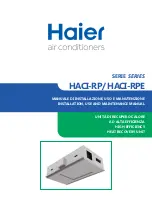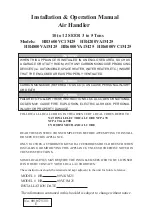
Air Handler
16
10. Condensate Removal
The drain pan has primary and secondary drain connection (Figure 7). Condensate water
discharging is performed by attaching a 3/4” PVC pipe to the evaporator coil pan and terminated
in accordance with local or state Plumbing/HVAC codes. The installation must include a “P” style
trap that is located closely to the evaporator coil. Do not over-tighten the drain connection(s) in
order to prevent possible damage to the evaporator drain pan. See Figure 8 for details of a typical
condensate line “P” trap.
Installations that are above a finished ceiling may require a field supplied auxiliary drain pan.
Consult local codes on this requirement.
Figure 8
Use a condensate removal pump when necessary. If the discharging pipe is blocked, the
condensate removal pump will be cut off to control voltage. A trap must be installed between the
unit and the condensate removal pump.
11. Start-Up Procedure
Prior to start-up, ensure that all electrical connections are properly sized and tightened.
All panels must be in place and secured. For air tight application, rubber gasket
must be
positioned at prescribed locations to achieve 2% leakage.
Tubing must be leak free.
Unit should be elevated, trapped and pitched to allow for drainage.
Low voltage wiring is connected.
Auxiliary drain is installed when necessary and pitched to allow for drainage.
Drain pan and drain tubing has been leak checked.
Return and supply ducts are sealed.
Unit is elevated when installed in a garage or where flammable vapors may be present.
Return air is not obtained from many areas where there may be objectionable odors,
flammable vapors or products of combustion such as carbon monoxide(CO), which may cause
serious personal injury or death.


































